Assessing PLA/PBSA Films for Sustainable Packaging for Moist and Perishable Foods
Abstract
1. Introduction
2. Materials and Methods
2.1. Materials
2.2. Preparation of Blends and Films
2.3. Films Characterization
3. Results
3.1. Melt Flow Rate Results
3.2. Phase Morphology Evolution and Composition Effects
3.3. Mechanical Properties of Films
3.4. Thermal Behavior
3.5. Barrier Properties
4. Conclusions
Author Contributions
Funding
Institutional Review Board Statement
Data Availability Statement
Acknowledgments
Conflicts of Interest
References
- Marano, S.; Laudadio, E.; Minnelli, C.; Stipa, P. Tailoring the Barrier Properties of PLA: A State-of-the-Art Review for Food Packaging Applications. Polymers 2022, 14, 1626. [Google Scholar] [CrossRef] [PubMed]
- Farah, S.; Anderson, D.G.; Langer, R. Physical and Mechanical Properties of PLA, and Their Functions in Widespread Applications—A Comprehensive Review. Adv. Drug Deliv. Rev. 2016, 107, 367–392. [Google Scholar] [CrossRef] [PubMed]
- Sun, S.; Weng, Y.; Zhang, C. Recent Advancements in Bio-Based Plasticizers for Polylactic Acid (PLA): A Review. Polym. Test. 2024, 140, 108603. [Google Scholar] [CrossRef]
- O’Loughlin, J.; Doherty, D.; Herward, B.; McGleenan, C.; Mahmud, M.; Bhagabati, P.; Boland, A.N.; Freeland, B.; Rochfort, K.D.; Kelleher, S.M.; et al. The Potential of Bio-Based Polylactic Acid (PLA) as an Alternative in Reusable Food Containers: A Review. Sustainability 2023, 15, 15312. [Google Scholar] [CrossRef]
- González-López, M.E.; Calva-Estrada, S.d.J.; Gradilla-Hernández, M.S.; Barajas-Álvarez, P. Current Trends in Biopolymers for Food Packaging: A Review. Front. Sustain. Food Syst. 2023, 7, 1225371. [Google Scholar] [CrossRef]
- Nasution, H.; Harahap, H.; Julianti, E.; Safitri, A.; Jaafar, M. Smart Packaging Based on Polylactic Acid: The Effects of Antibacterial and Antioxidant Agents from Natural Extracts on Physical–Mechanical Properties, Colony Reduction, Perishable Food Shelf Life, and Future Prospective. Polymers 2023, 15, 4103. [Google Scholar] [CrossRef]
- Kabir, E.; Kaur, R.; Lee, J.; Kim, K.-H.; Kwon, E.E. Prospects of Biopolymer Technology as an Alternative Option for Non-Degradable Plastics and Sustainable Management of Plastic Wastes. J. Clean. Prod. 2020, 258, 120536. [Google Scholar] [CrossRef]
- Safandowska, M.; Makarewicz, C.; Rozanski, A. Tuning Barrier Properties of Low-Density Polyethylene: Impact of Amorphous Region Nanostructure on Gas Transmission Rate. Molecules 2024, 29, 4950. [Google Scholar] [CrossRef]
- Mosallaie, F.; Falah, F.; Yazdi, F.T.; Mortazavi, S.A.; Vasiee, A. Development of Postbiotic Supplemented Polylactic Acid Films for Improving Quality and Shelf Life of Rainbow Trout. Sci. Rep. 2025, 15, 24305. [Google Scholar] [CrossRef]
- Qin, Y.; Wang, Y.; Wu, Y.; Zhang, Y.; Li, H.; Yuan, M. Effect of Hexadecyl Lactate as Plasticizer on the Properties of Poly(l-Lactide) Films for Food Packaging Applications. J. Polym. Environ. 2015, 23, 374–382. [Google Scholar] [CrossRef]
- Ghasemlou, M.; Barrow, C.J.; Adhikari, B. The Future of Bioplastics in Food Packaging: An Industrial Perspective. Food Packag. Shelf Life 2024, 43, 101279. [Google Scholar] [CrossRef]
- Bao, L.; Dorgan, J.R.; Knauss, D.; Hait, S.; Oliveira, N.S.; Maruccho, I.M. Gas Permeation Properties of Poly(Lactic Acid) Revisited. J. Membr. Sci. 2006, 285, 166–172. [Google Scholar] [CrossRef]
- Gigante, V.; Aliotta, L.; Ascrizzi, R.; Pistelli, L.; Zinnai, A.; Batoni, G.; Coltelli, M.-B.; Lazzeri, A. Innovative Biobased and Sustainable Polymer Packaging Solutions for Extending Bread Shelf Life: A Review. Polymers 2023, 15, 4700. [Google Scholar] [CrossRef]
- Holm, V.; Mortensen, G.; Risbo, J. Quality Changes in Semi-Hard Cheese Packaged in a Poly(Lactic Acid) Material. Food Chem. 2006, 97, 401–410. [Google Scholar] [CrossRef]
- Leejarkpai, T.; Mungcharoen, T.; Suwanmanee, U. Comparative Assessment of Global Warming Impact and Eco-Efficiency of PS (Polystyrene), PET (Polyethylene Terephthalate) and PLA (Polylactic Acid) Boxes. J. Clean. Prod. 2016, 125, 95–107. [Google Scholar] [CrossRef]
- Fiorentini, C.; Leni, G.; de Apodaca, E.D.; Fernández-de-Castro, L.; Rocchetti, G.; Cortimiglia, C.; Spigno, G.; Bassani, A. Development of Coated PLA Films Containing a Commercial Olive Leaf Extract for the Food Packaging Sector. Antioxidants 2024, 13, 519. [Google Scholar] [CrossRef]
- Gigante, V.; Aliotta, L.; Canesi, I.; Mallegni, N.; Giangrandi, S.; Braca, F.; Coltelli, M.B.; Cinelli, P.; Lazzeri, A. Development of Antimicrobial and Hydrophobic Hot-melt BioCoatings for Cellulosic and Biobased Plastic Substrates. J. Vinyl Addit. Technol. 2025, 31, 985–1000. [Google Scholar] [CrossRef]
- Arrieta, M.P.; Castro-López, M.D.M.; Rayón, E.; Barral-Losada, L.F.; López-Vilariño, J.M.; López, J.; González-Rodríguez, M.V. Plasticized Poly (Lactic Acid)–Poly (Hydroxybutyrate)(PLA–PHB) Blends Incorporated with Catechin Intended for Active Food-Packaging Applications. J. Agric. Food Chem. 2014, 62, 10170–10180. [Google Scholar] [CrossRef] [PubMed]
- Cabedo, L.; Luis Feijoo, J.; Pilar Villanueva, M.; Lagarón, J.M.; Giménez, E. Optimization of Biodegradable Nanocomposites Based on APLA/PCL Blends for Food Packaging Applications. Macromol. Symp. 2006, 233, 191–197. [Google Scholar] [CrossRef]
- Apicella, A.; Molinari, G.; Gigante, V.; Pietrosanto, A.; Incarnato, L.; Aliotta, L.; Lazzeri, A. Poly(Lactic Acid) (PLA)/Poly(Butylene Succinate Adipate) (PBSA) Films with Micro Fibrillated Cellulose (MFC) and Cardanol for Packaging Applications. Cellulose 2024, 31, 9173–9190. [Google Scholar] [CrossRef]
- Ordoñez, R.; Atarés, L.; Chiralt, A. Multilayer Antimicrobial Films Based on Starch and PLA with Superficially Incorporated Ferulic or Cinnamic Acids for Active Food Packaging Purposes. Food Chem. Adv. 2023, 2, 100250. [Google Scholar] [CrossRef]
- Jahangiri, F.; Mohanty, A.K.; Misra, M. Sustainable Biodegradable Coatings for Food Packaging: Challenges and Opportunities. Green. Chem. 2024, 26, 4934–4974. [Google Scholar] [CrossRef]
- Bužarovska, A.; Dimitrovski, D.; Petkoska, A.T. Development of Poly(L-Lactic Acid) Films Containing Curcuma Lunga, L. Extract for Active Cheese Packaging. Processes 2025, 13, 1881. [Google Scholar] [CrossRef]
- Lin, L.; Deng, C.; Lin, G.-P.; Wang, Y.-Z. Super Toughened and High Heat-Resistant Poly(Lactic Acid) (PLA)-Based Blends by Enhancing Interfacial Bonding and PLA Phase Crystallization. Ind. Eng. Chem. Res. 2015, 54, 5643–5655. [Google Scholar] [CrossRef]
- Gigante, V.; Bosi, L.; Parlanti, P.; Gemmi, M.; Aliotta, L.; Lazzeri, A. Analysis of the Damage Mechanism around the Crack Tip for Two Rubber-Toughened PLA-Based Blends. Polymers 2021, 13, 4053. [Google Scholar] [CrossRef] [PubMed]
- Lascano, D.; Quiles-Carrillo, L.; Balart, R.; Boronat, T.; Montanes, N. Toughened Poly (Lactic Acid)-PLA Formulations by Binary Blends with Poly(Butylene Succinate-Co-Adipate)-PBSA and Their Shape Memory Behaviour. Materials 2019, 12, 622. [Google Scholar] [CrossRef] [PubMed]
- Taniguchi, A.; Shirakashi, S.; Kawagishi, T.; Tanaka, A.; Eguchi, M. The Biodegradable Polymer Poly(Butylene Succinate-Co-Adipate) Modulates the Community Structures of Actively Growing Bacteria in Rotifer Culture Water. Sci. Rep. 2025, 15, 5572. [Google Scholar] [CrossRef]
- Aliotta, L.; Vannozzi, A.; Canesi, I.; Cinelli, P.; Coltelli, M.-B.; Lazzeri, A. Poly(Lactic Acid) (PLA)/Poly(Butylene Succinate-Co-Adipate) (PBSA) Compatibilized Binary Biobased Blends: Melt Fluidity, Morphological, Thermo-Mechanical and Micromechanical Analysis. Polymers 2021, 13, 218. [Google Scholar] [CrossRef] [PubMed]
- Aliotta, L.; Dal Pont, B.; Gigante, V.; Russo, P.; Passaro, J.; Lazzeri, A. Investigation of New Poly(Lactic Acid) (PLA)/Poly(Butylene Succinate-Co-Adipate) (PBSA) Thermoplastic Composites Reinforced with Different Amount of Twill Hemp Fabrics. J. Mater. Sci. 2024, 59, 847–862. [Google Scholar] [CrossRef]
- Aliotta, L.; Gigante, V.; Dal Pont, B.; Miketa, F.; Coltelli, M.-B.; Lazzeri, A. Tearing Fracture of Poly(Lactic Acid) (PLA)/Poly(Butylene Succinate-Co-Adipate) (PBSA) Cast Extruded Films: Effect of the PBSA Content. Eng. Fract. Mech. 2023, 289, 109450. [Google Scholar] [CrossRef]
- Nofar, M.; Salehiyan, R.; Ciftci, U.; Jalali, A.; Durmuş, A. Ductility Improvements of PLA-Based Binary and Ternary Blends with Controlled Morphology Using PBAT, PBSA, and Nanoclay. Compos. B Eng. 2020, 182, 107661. [Google Scholar] [CrossRef]
- Sabalina, A.; Gaidukovs, S.; Aunins, A.; Gromova, A.; Gaidukova, G.; Orlova, L.; Platnieks, O. Exploring the Processing Potential of Polylactic Acid, Polyhydroxyalkanoate, and Poly(Butylene Succinate-Co-Adipate) Binary and Ternary Blends. Polymers 2024, 16, 2288. [Google Scholar] [CrossRef]
- ISO 1133-2:2011; Plastics—Determination of the Melt Mass-Flow Rate (MFR) and Melt Volume-Flow Rate (MVR) of Thermoplastics—Part 2: Method for Materials Sensitive to Time-Temperature History and/or Moisture. ISO: Geneva, Switzerland, 2011.
- Andrade, D.S.C.; Canedo, E.L.; de Carvalho, L.H.; Barbosa, R.; Alves, T.S. Characterization of Poly(Ethylene Terephthalate) by Torque Rheometry. Mater. Res. 2021, 24, e20200238. [Google Scholar] [CrossRef]
- Seggiani, M.; Gigante, V.; Cinelli, P.; Coltelli, M.B.; Sandroni, M.; Anguillesi, I.; Lazzeri, A. Processing and Mechanical Performances of Poly(Butylene Succinate–Co–Adipate)(PBSA)and Raw Hydrolyzed Collagen (HC)Thermoplastic Blends. Polym. Test. 2019, 77, 105900. [Google Scholar] [CrossRef]
- Gigante, V.; Aliotta, L.; Coltelli, M.B.; Cinelli, P.; Botta, L.; La Mantia, F.P.; Lazzeri, A. Fracture Behavior and Mechanical, Thermal, and Rheological Properties of Biodegradable Films Extruded by Flat Die and Calender. J. Polym. Sci. 2020, 58, 3264–3282. [Google Scholar] [CrossRef]
- Everaert, V.; Aerts, L.; Groeninckx, G. Phase Morphology Development in Immiscible PP/(PS/PPE) Blends Influence of the Melt-Viscosity Ratio and Blend Composition. Polymer 1999, 40, 6627–6644. [Google Scholar] [CrossRef]
- Chen, S.C.; Tsai, R.I.; Chien, R.D.; Lin, T.K. Preliminary Study of Polymer Melt Rheological Behavior Flowing through Micro-Channels. Int. Commun. Heat. Mass. Transf. 2005, 32, 501–510. [Google Scholar] [CrossRef]
- Yuniarto, K.; Purwanto, Y.A.; Purwanto, S.; Welt, B.A.; Purwadaria, H.K.; Sunarti, T.C. Infrared and Raman Studies on Polylactide Acid and Polyethylene Glycol-400 Blend. In AIP Conference Proceedings; AIP Publishing LLC: Melville, NY, USA, 2016; Volume 1725. [Google Scholar] [CrossRef]
- Malinowski, R.; Moraczewski, K.; Raszkowska-Kaczor, A. Studies on the Uncrosslinked Fraction of PLA/PBAT Blends Modified by Electron Radiation. Materials 2020, 13, 1068. [Google Scholar] [CrossRef] [PubMed]
- Harder, N.; Rodriguez-Uribe, A.; Snowdon, M.R.; Misra, M.; Mohanty, A.K. Hop Natural Fiber-Reinforced Poly(Butylene Succinate-Co-Butylene Adipate) (PBSA) Biodegradable Plastics: Effect of Fiber Length on the Performance of Biocomposites. Mater. Adv. 2023, 4, 1502–1514. [Google Scholar] [CrossRef]
- Yao, S.-F.; Chen, X.-T.; Ye, H.-M. Investigation of Structure and Crystallization Behavior of Poly(Butylene Succinate) by Fourier Transform Infrared Spectroscopy. J. Phys. Chem. B 2017, 121, 9476–9485. [Google Scholar] [CrossRef]
- Yan, C.; Zhang, Y.; Hu, Y.; Ozaki, Y.; Shen, D.; Gan, Z.; Yan, S.; Takahashi, I. Melt Crystallization and Crystal Transition of Poly(Butylene Adipate) Revealed by Infrared Spectroscopy. J. Phys. Chem. B 2008, 112, 3311–3314. [Google Scholar] [CrossRef]
- Palai, B.; Mohanty, S.; Nayak, S.K. Synergistic Effect of Polylactic Acid(PLA) and Poly(Butylene Succinate-Co-Adipate) (PBSA) Based Sustainable, Reactive, Super Toughened Eco-Composite Blown Films for Flexible Packaging Applications. Polym. Test. 2020, 83, 106130. [Google Scholar] [CrossRef]
- Praveena, N.M.; Shaiju, P.; Raj, R.B.A.; Gowd, E.B. Infrared Bands to Distinguish Amorphous, Meso and Crystalline Phases of Poly(Lactide)s: Crystallization and Phase Transition Pathways of Amorphous, Meso and Co-Crystal Phases of Poly(ʟ-Lactide) in the Heating Process. Polymer 2022, 240, 124495. [Google Scholar] [CrossRef]
- Zhao, T.; Yu, J.; Zhang, X.; Han, W.; Zhang, S.; Pan, H.; Zhang, Q.; Yu, X.; Bian, J.; Zhang, H. Thermal, Crystallization, and Mechanical Properties of Polylactic Acid (PLA)/Poly(Butylene Succinate) (PBS) Blends. Polym. Bull. 2024, 81, 2481–2504. [Google Scholar] [CrossRef]
- Shariatpanahi, H.; Nazokdast, H.; Hemmati, M. Dispersed Phase Particle Size in Polymer Blends: Interfacial and Rheological Effects. J. Elastomers Plast. 2003, 35, 115–131. [Google Scholar] [CrossRef]
- Willemse, R.C.; Speijer, A.; Langeraar, A.E.; Posthuma de Boer, A. Tensile Moduli of Co-Continuous Polymer Blends. Polymer 1999, 40, 6645–6650. [Google Scholar] [CrossRef]
- Pötschke, P.; Paul, D.R. Formation of Co-Continuous Structures in Melt-Mixed Immiscible Polymer Blends. J. Macromol. Sci. Part C 2003, 43, 87–141. [Google Scholar] [CrossRef]
- Veenstra, H.; Verkooijen, P.C.J.; van Lent, B.J.J.; van Dam, J.; de Boer, A.P.; Nijhof, A.P.H.J. On the Mechanical Properties of Co-Continuous Polymer Blends: Experimental and Modelling. Polymer 2000, 41, 1817–1826. [Google Scholar] [CrossRef]
- Bellon, J.; Bacoup, F.; Marais, S.; Gattin, R. PLA, PBS, and PBAT Biocomposites—Part A: Matrix–Filler Interactions with Agro-Industrial Waste Fillers (Brewer’s Spent Grain, Orange Peel) and Their Influence on Thermal, Mechanical, and Water Sorption Properties. Materials 2025, 18, 3867. [Google Scholar] [CrossRef]
- Yang, X.; Xu, H.; Odelius, K.; Hakkarainen, M. Poly(Lactide)-g-Poly(Butylene Succinate-Co-Adipate) with High Crystallization Capacity and Migration Resistance. Materials 2016, 9, 313. [Google Scholar] [CrossRef]
- Gigante, V.; Aliotta, L.; Dal Pont, B.; Titone, V.; Botta, L.; La Mantia, F.P.; Lazzeri, A. Tailoring Morphology and Mechanical Properties of PLA/PBSA Blends Optimizing the Twin-Screw Extrusion Processing Parameters Aided by a 1D Simulation Software. Polym. Test. 2023, 129, 108294. [Google Scholar] [CrossRef]
- Zhu, Y.; Zhang, X.; Jia, S.; Yan, Z.; Liang, W.; Zhang, Y.; Coates, P.; Liu, W. Recent Reviews for Isothermal Crystallization Kinetics and Its Regulation Strategies of PLA. J. Polym. Res. 2024, 31, 253. [Google Scholar] [CrossRef]
- Skotnicki, M.; Drogoń, A.; Lulek, J.; Pyda, M. Physical Ageing of Amorphous Poly(Lactic Acid)-Indapamide System Studied by Differential Scanning Calorimetry. Pharmaceutics 2023, 15, 2341. [Google Scholar] [CrossRef]
- Shi, X.; Qin, J.; Wang, L.; Ren, L.; Rong, F.; Li, D.; Wang, R.; Zhang, G. Introduction of Stereocomplex Crystallites of PLA for the Solid and Microcellular Poly(Lactide)/Poly(Butylene Adipate-Co-Terephthalate) Blends. RSC Adv. 2018, 8, 11850–11861. [Google Scholar] [CrossRef]
- Yang, S.; Li, S.-R.; Zhou, S.-Y.; Yang, H.-R.; Xu, L.; Zhong, G.-J.; Xu, J.-Z.; Li, Z.-M.; Tao, X.-M.; Mai, Y.-W. Cold Crystallization Behavior of Poly(Lactic Acid) Induced by Poly(Ethylene Glycol)-Grafted Graphene Oxide: Crystallization Kinetics and Polymorphism. Compos. Sci. Technol. 2024, 258, 110871. [Google Scholar] [CrossRef]
- Wang, Y.; Bhattacharya, M.; Mano, J.F. Thermal Analysis of the Multiple Melting Behavior of Poly(Butylene Succinate-Co-adipate). J. Polym. Sci. B Polym. Phys. 2005, 43, 3077–3082. [Google Scholar] [CrossRef]
- Anese, R.d.O.; Brackmann, A.; Thewes, F.R.; Schultz, E.E.; De Gasperin, A.R. Mass Loss by Low Relative Humidity Increases Gas Diffusion Rates in Apple Flesh and Allows the Use of High CO2 Partial Pressures during Ultralow O2 Storage. Sci. Hortic. 2016, 198, 414–423. [Google Scholar] [CrossRef]
- Kumar Vinayak, A.; Kumar, V.; Venkatachalam, S. Moisture Barrier Behavior of Polymer Films on Food Packaging Plastic Materials. Int. J. Technol. Res. Eng. 2022, 9, 2347–4718. [Google Scholar] [CrossRef]
- Gaikwad, K.K.; Singh, S.; Ajji, A. Moisture Absorbers for Food Packaging Applications. Environ. Chem. Lett. 2019, 17, 609–628. [Google Scholar] [CrossRef]
- Kiese, S.; Kücükpinar, E.; Miesbauer, O.; Langowski, H.-C. Time-Dependent Water Vapor Permeation through Multilayer Barrier Films: Empirical versus Theoretical Results. Thin Solid Film. 2019, 672, 199–205. [Google Scholar] [CrossRef]
- Mutsuga, M.; Kawamura, Y.; Tanamoto, K. Migration of Lactic Acid, Lactide and Oligomers from Polylactide Food-Contact Materials. Food Addit. Contam. Part A 2008, 25, 1283–1290. [Google Scholar] [CrossRef] [PubMed]
- Scarfato, P.; Di Maio, L.; Milana, M.R.; Giamberardini, S.; Denaro, M.; Incarnato, L. Performance Properties, Lactic Acid Specific Migration and Swelling by Simulant of Biodegradable Poly(Lactic Acid)/Nanoclay Multilayer Films for Food Packaging. Food Addit. Contam. Part A 2017, 34, 1730–1742. [Google Scholar] [CrossRef] [PubMed]
- Ubeda, S.; Aznar, M.; Alfaro, P.; Nerín, C. Migration of Oligomers from a Food Contact Biopolymer Based on Polylactic Acid (PLA) and Polyester. Anal. Bioanal. Chem. 2019, 411, 3521–3532. [Google Scholar] [CrossRef] [PubMed]
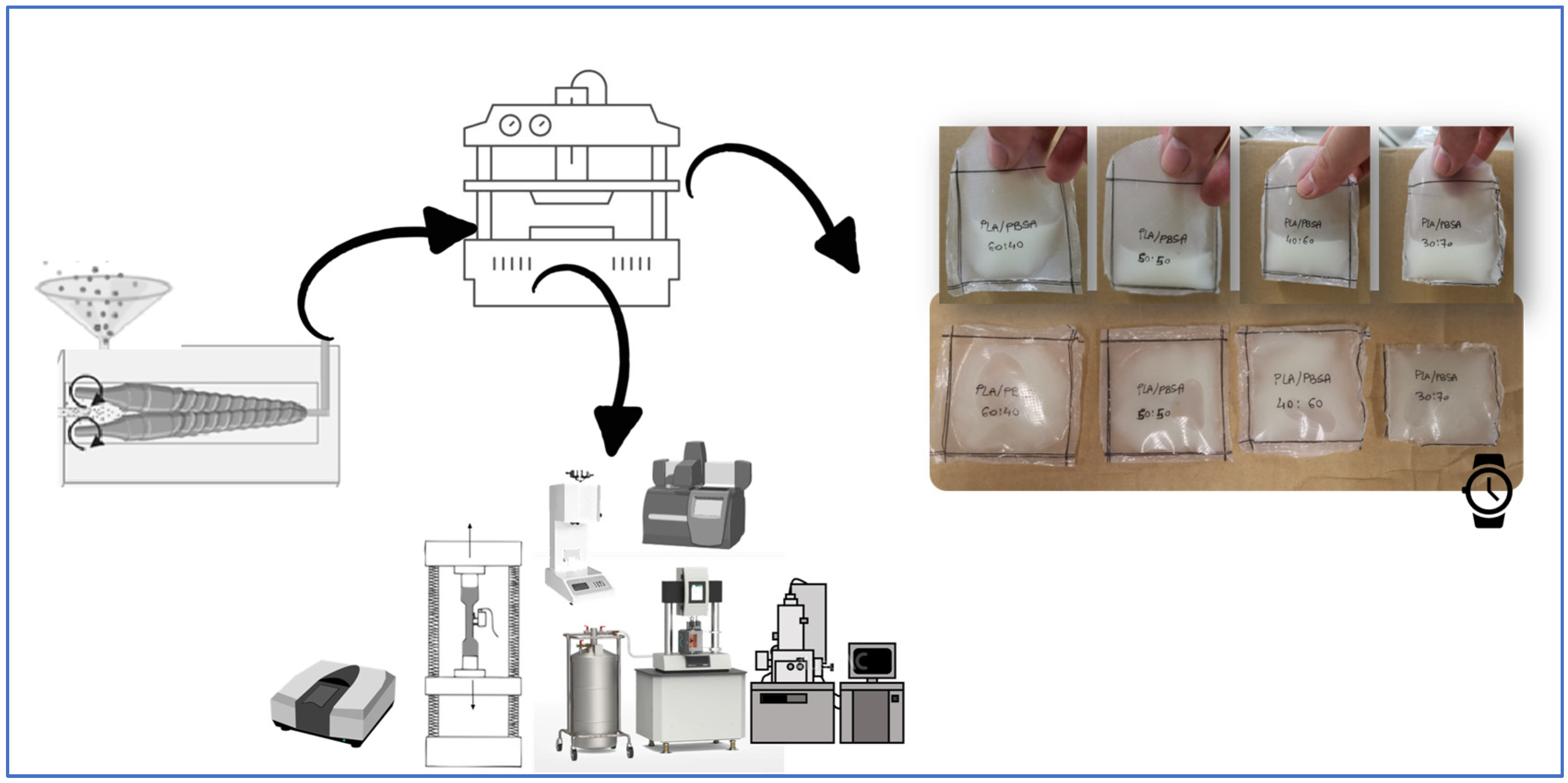
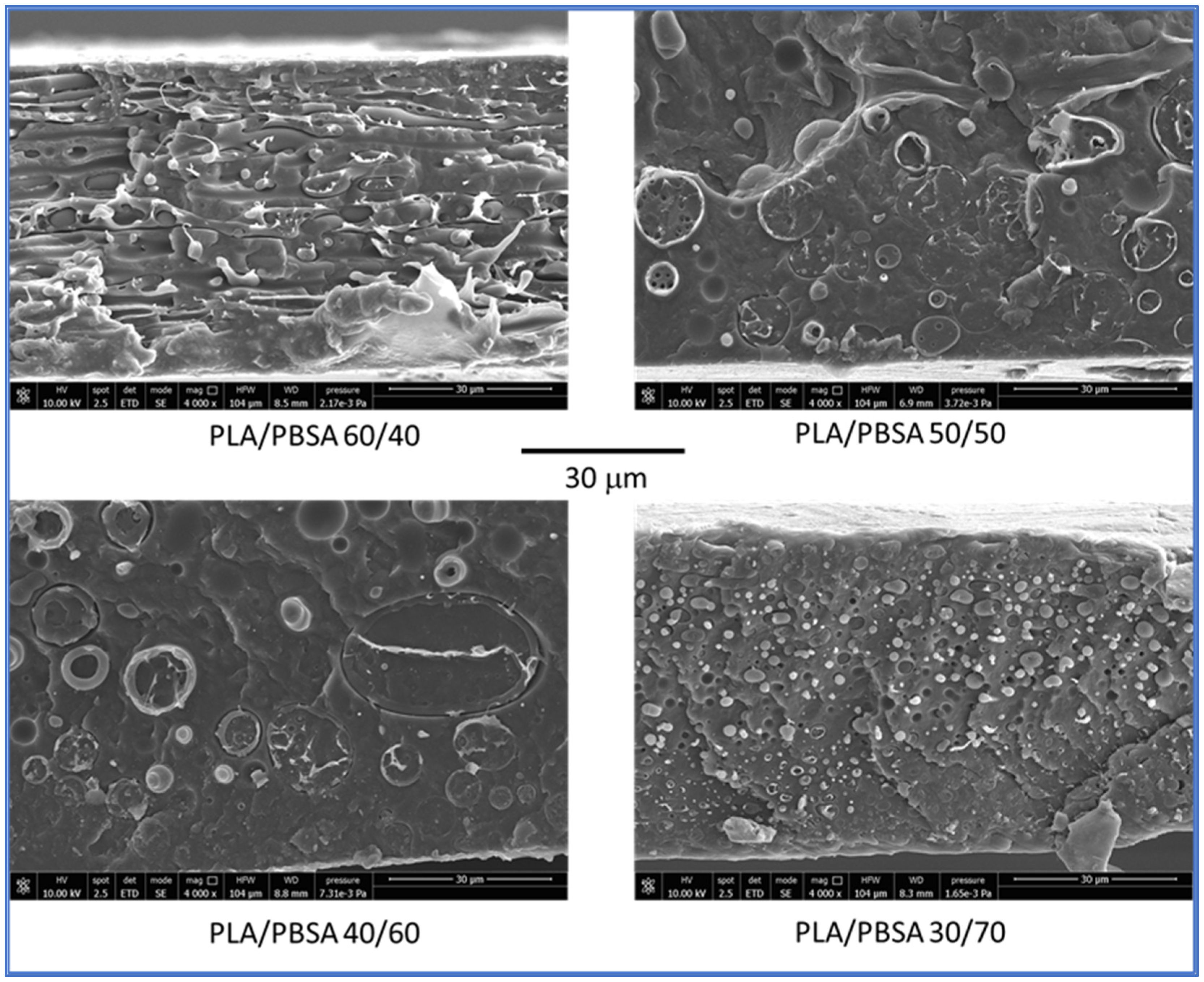

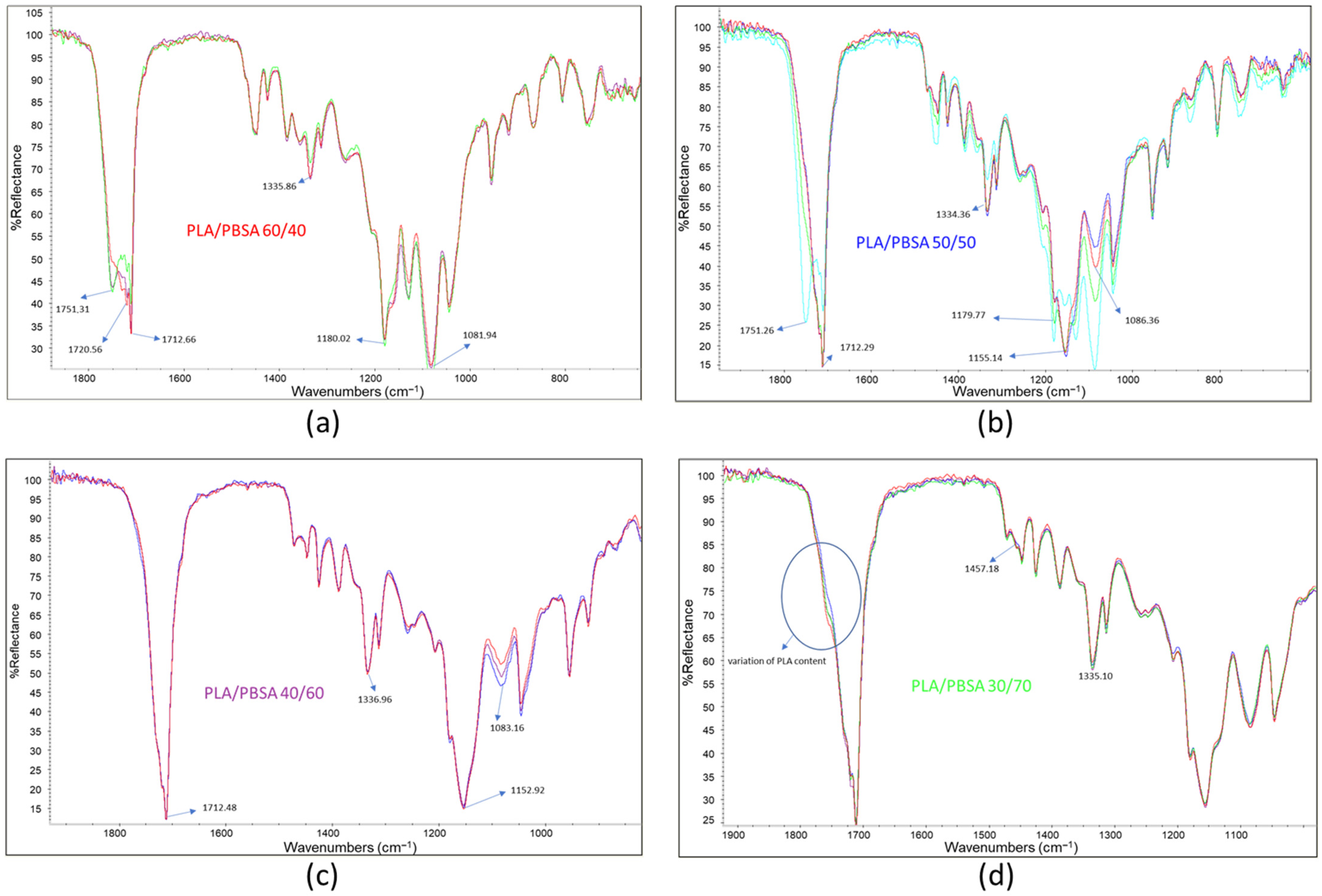

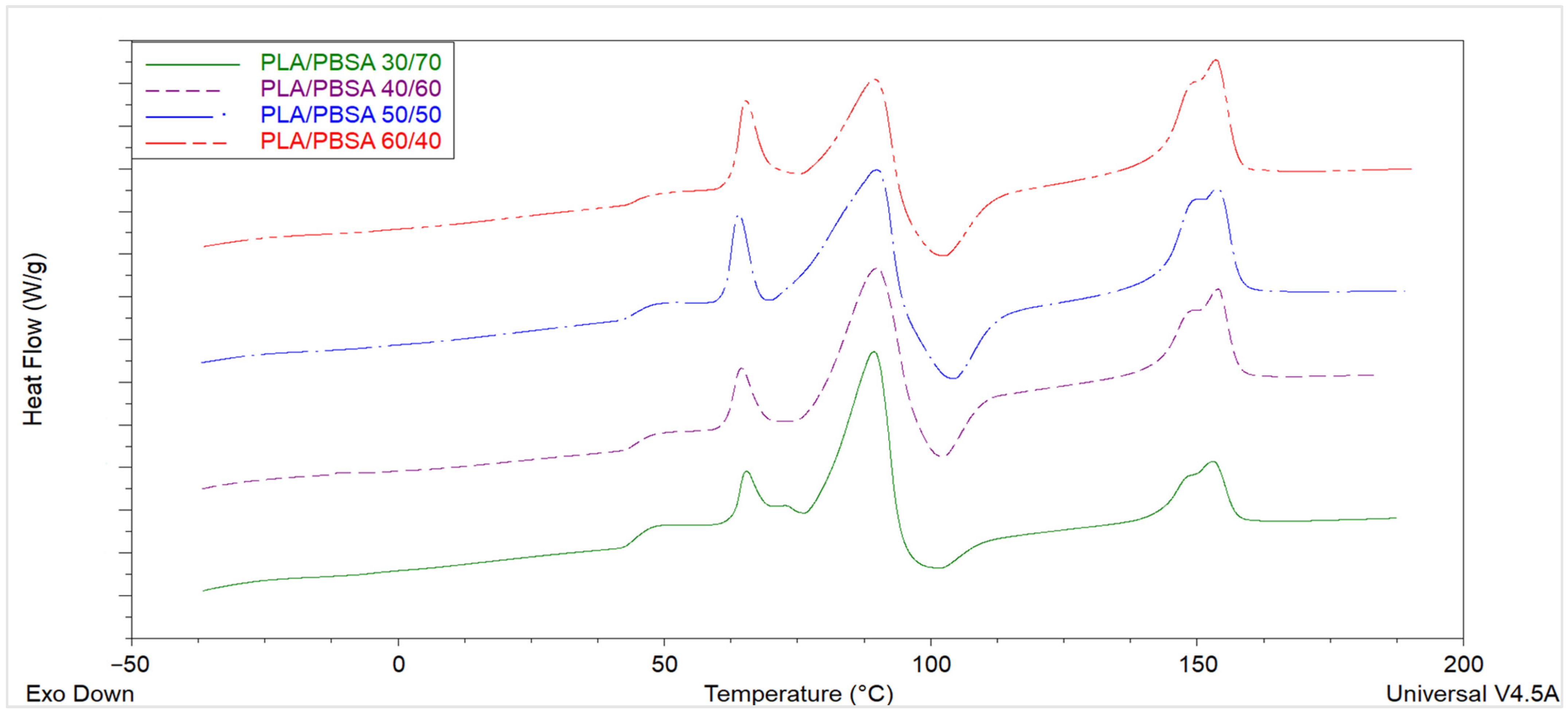
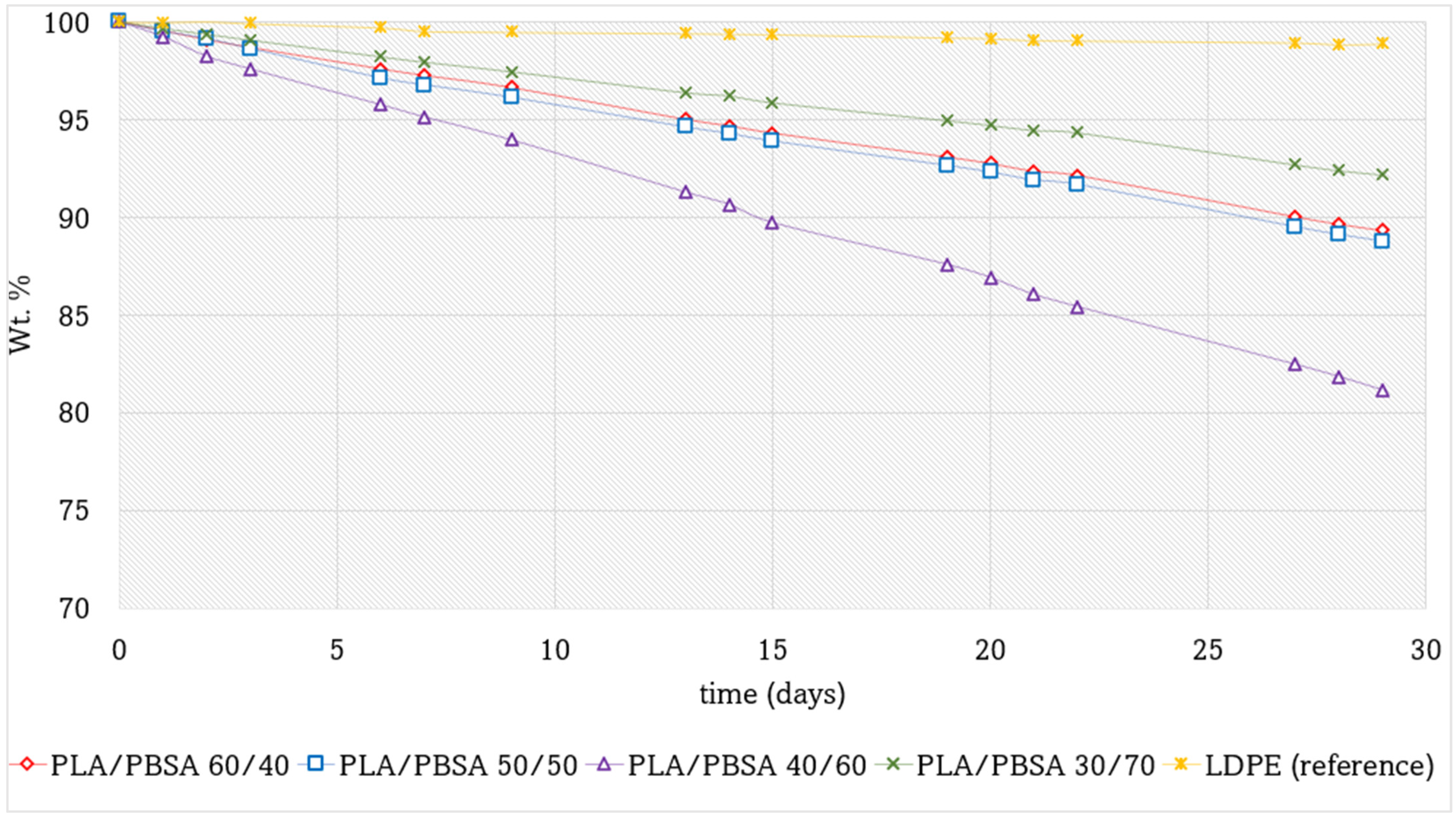
| Samples | PLA (wt%) | PBSA (wt%) |
|---|---|---|
| PLA/PBSA 60/40 | 60 | 40 |
| PLA/PBSA 50/50 | 50 | 50 |
| PLA/PBSA 40/60 | 40 | 60 |
| PLA/PBSA 30/70 | 30 | 70 |
| Samples | MVR (cm3/10 min) | MFR (g/10 min) |
|---|---|---|
| PLA/PBSA 60/40 | 4.4 ± 0.1 | 5.0 ± 0.2 |
| PLA/PBSA 50/50 | 4.1 ± 0.3 | 4.5 ±0.2 |
| PLA/PBSA 40/60 | 3.9 ± 0.3 | 4.2 ± 0.3 |
| PLA/PBSA 30/70 | 3.5 ± 0.3 | 3.7 ± 0.4 |
Disclaimer/Publisher’s Note: The statements, opinions and data contained in all publications are solely those of the individual author(s) and contributor(s) and not of MDPI and/or the editor(s). MDPI and/or the editor(s) disclaim responsibility for any injury to people or property resulting from any ideas, methods, instructions or products referred to in the content. |
© 2025 by the authors. Licensee MDPI, Basel, Switzerland. This article is an open access article distributed under the terms and conditions of the Creative Commons Attribution (CC BY) license (https://creativecommons.org/licenses/by/4.0/).
Share and Cite
Coltelli, M.-B.; Cartoni, F.; Panariello, L.; Aliotta, L.; Gigante, V.; Lazzeri, A. Assessing PLA/PBSA Films for Sustainable Packaging for Moist and Perishable Foods. Polymers 2025, 17, 3093. https://doi.org/10.3390/polym17233093
Coltelli M-B, Cartoni F, Panariello L, Aliotta L, Gigante V, Lazzeri A. Assessing PLA/PBSA Films for Sustainable Packaging for Moist and Perishable Foods. Polymers. 2025; 17(23):3093. https://doi.org/10.3390/polym17233093
Chicago/Turabian StyleColtelli, Maria-Beatrice, Francesca Cartoni, Luca Panariello, Laura Aliotta, Vito Gigante, and Andrea Lazzeri. 2025. "Assessing PLA/PBSA Films for Sustainable Packaging for Moist and Perishable Foods" Polymers 17, no. 23: 3093. https://doi.org/10.3390/polym17233093
APA StyleColtelli, M.-B., Cartoni, F., Panariello, L., Aliotta, L., Gigante, V., & Lazzeri, A. (2025). Assessing PLA/PBSA Films for Sustainable Packaging for Moist and Perishable Foods. Polymers, 17(23), 3093. https://doi.org/10.3390/polym17233093










